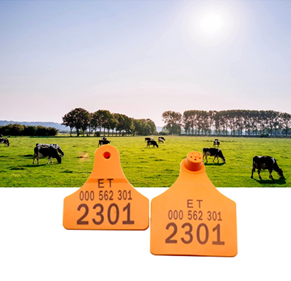
As pecuárias sempre foram propensas a sair de epidemias de animais. Nós testemunhamos surto de Gripe Aviária, H1NI Suinos Flu, Nipah, Ebola e agora COVID-19.
Muitos países tomaram ações sérias para controlar um novo surto de uma epidemia e têm regulado o manejo da pecuária e dos animais. Various technologies are being used for identification and monitoring of livestock and proper management of animal husbandries. There are few must use products by Animal Husbandry post COVID.
The most important change that has been made to the livestock controlling and monitoring is the use of RFID technology. The RFID enabled tags use the EID number or the management number on the button that is placed on the animal. As informações na tag são lidas e armazenadas com a ajuda de ondas de rádio. This technology is less time consuming, more economical and accurate.
Why Animal Husbandry uses RFID tags?
1. Aplicação vitalícia: RFID tags stay attached on the animal for the lifetime and don’t fall out or become unreadable when covered in dirt or mud. A maioria dessas etiquetas são impermeáveis e resistentes a choques. As tags RFID tornam o gerenciamento da fazenda fácil e menos demorado.
2. Fácil implementação: Cada tag tem um número de identificação único impresso nele que pode ser facilmente digitalizado através de um leitor EID. Não é necessário papelada.. Todo o processo é informatizado melhorando a precisão dos dados. Ao contrário das etiquetas visuais, As etiquetas RFID podem ser escaneadas mesmo à distância e não exigem que o animal fique parado, ou um contato visual entre o leitor e a tag. As tags RFID são mais seguras e minimizam as chances de qualquer erro.
3. Rentável: RFID tags are cost effective and more efficient. Seu recurso de longa duração os torna mais baratos do que outras marcas que precisam ser substituídas devido ao desgaste e queda do animal. A tecnologia requer menos intervenção humana. Portanto, reduz o custo da mão-de-obra também.
4. Fácil monitoramento: Agricultores e pecuaristas podem monitorar a saúde de seus bovinos desde o nascimento até o abate. Verifique se há alguma doença animal, rastrear o movimento animal sem perturbá-los e gravar seu transporte de um único dispositivo.
5. Government Regulation: Many countries have made it mandatory to use the RFID tags in order to quickly trace an outbreak of livestock diseases. O tradicional, sistema de rastreamento não eletrônico pode levar vários meses para rastrear tais surtos.
Here are the MUST USE RFID products by Animal Husbandry
1. Tag de orelha RFID: RFID ear tag is a plastic or metal object that carries an identification number on it and is placed in the ears of an animal. It carries a fifteen-digit unique Animal Identification Number (Ain) juntamente com poucos outros detalhes, como número de identificação de propriedade. O AIN consiste em um código da empresa de 3 dígitos e um número animal individual de 12 dígitos. Pode ser aplicado à mão ou por um aplicador de etiqueta de ouvido. Um leitor de identificação é usado para digitalizar e coletar os dados dessas tags, que é então baixado e armazenado em um computador. Este processo reduz as chances de erro e mantém um registro de todos os dados relacionados a um animal em um outro.

RFIDHY Ear Tag vêm em frequências diferentes de 134.2KHz, 125KHz até tão baixo quanto 860 MHz e 960MHz. The waterproof and shock-resistant RFID tag is designed in a way to implement the technology efficiently and hassle-free. Com um 100% garantia de desempenho, RFIDHY’s ear tag last for the lifetime of the animal. The electrical parts of the RFIDHY Ear Tag is covered by TPU material which is convenient and strong in the harsh environment too. RFIDY lhe dá a vantagem de escolher os números de ID de acordo com o seu requisito. Você também pode escolher sua cor e o conteúdo que deseja imprimir nas tags. Essas etiquetas certificadas ISO-11784/11785 vêm com uma garantia de três anos.
2. Tag RFID vidro: Glass Tag is essentially a tiny transponder that stores information and emits radio frequency. It comes in the form of a miniature capsule not bigger than grain of rice. The capsule contains a microchip containing a unique code. Unlike ear tags that are placed on the animal body, glass tags are injected in the animal body like vaccines. The information on the tag is scanned with a RFID tag reader by scanning the surface of the animal skin. The reader captures all the details mentioned on the tag with accuracy.

RFIDHY Glass Tube Tag is a glass RFID chip embedded transponder manufactured by fully automatic production technology thereby ensuring the consistency and reliability of its quality. It offers a variety of chip options in both low and high frequency. It has high Q Value and sensitivity that protects it from harsh environment. Being heat resistant and stable, it can be imbedded in a broad spectrum of potential enclosure material. It has unlimited resistance to water and chemical absorption. The tag has memory storage options from 64 pouco leitura-somente para 2048 pouco ler-escrever.
The RFID tags are recommended for cattle, Ovelhas, goats, pigs and other pet animals. These tags are widely used in slaughter houses, poultry houses and hatcheries to identify and monitor the livestock. Track any disease and keep a check on their health. They are used in keeping records of the livestock movement, their feeding and vaccination schedules too. These features of RFID tags make them a must use product for the Animal Husbandry industry after the world recovers from COVID.





